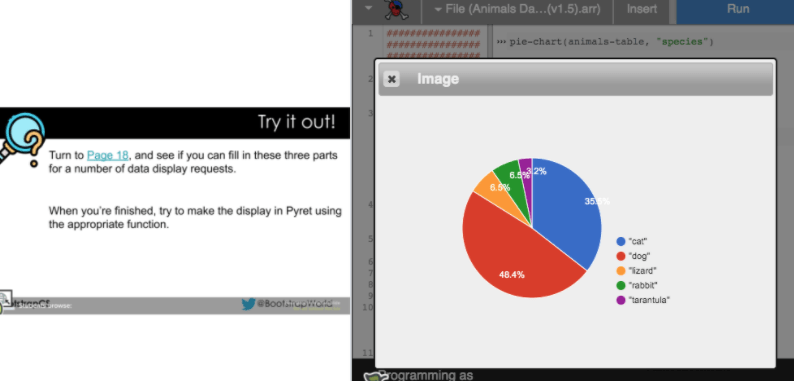
Over the past two years, we've completely rewritten our entire curriculum library into a new format we call "Remix". This is the most ambitious change to our materials in our 13 year history, and we're excited to share it with you! This series of posts will focus on the problems Remix solves, and what that means for teachers. If you'd like to read them all, here's your table of contents:
Right now teachers across the country are confronting the challenge of virtual instruction. Many teachers have done the best they could by taking existing materials and delivering them over Zoom. But we've all learned the hard way that this isn't the answer. High-quality remote instruction is only possible when the materials have been designed for it.
Today we'll be talking about two common obstacles for remote instruction, and how Remix addresses both.
One of the most common problems faced by classroom teachers is window management:
Every Bootstrap lesson plan now ships with its own PearDeck-Enhanced Google Slides, which allow teachers to add interactive features to their presentations. Instead of sharing your screen over a video conferencing tool (not exactly a workable solution for students with slow internet!), teachers start their own "presentation sessions" and have students log in via a link. This brings up the slides themselves - not a video! - on students' computers.

These slides can embed polls, free response questions, multiple choice questions, audio, pre-recorded, videos, and even our Pyret and WeScheme editors! No need to worry about what tabs students are looking at, or whether they all clicked the right link: once they log into the presentation session, everything is all in the same browser window!
Our new PearDeck slides solve this neatly: students have a single browser tab open, and that's it. It solves a major in-class problem, and a much more serious remote-instruction problem.
Presenting a slide deck, showing a video or scrolling through a PDF over tools like Zoom is problematic. Scrolling through a 10kb text file over a video-conferencing tool requires fast internet, because the streamed video of you scrolling can many megabytes per second. For students logging in via a school-provided laptop, tethered through their cellular phone or using a slow connection at home, this is a nonstarter!
Math teachers love tools like Desmos and Geogebra for providing interactive resources to explore concepts (like this one, used in Data Science course). Even for the lucky students who have broadband, it's impossible for them to copy/paste text or interact with the content you're showing them. They're just sitting passively, watching a video of whatever they would be doing…if only they were in class.
When our new slides are presented via PearDeck, students are seeing the actual slides. Embedded Desmos activity or Pyret Editor? No problem. Video? Sure - and students can pause and rewind if they need to. The only time students need a connection fast enough to handle video is if you are showing them video. Otherwise, they only use the bandwidth they need.
Our new slide format is just one way that the changes in Remix will benefit everyone - regardless of what context they happen to be teaching in.
We want to publicly thank Dorai Sitaram, the architect of this new system. We also want to thank Ed Campos for his curation of great 3rd-party math resources, graphic design and Google Slides chops, and Jennifer Poole for her work writing dozens of lesson plans and spearheading the Standards Alignment effort.
Our previous infrastructure was built 8 years ago by Danny Yoo (who is also the author of WeScheme!), and Kathi Fisler has heroically maintained it since then.
Stay tuned for future posts on some of the other exciting things made possible by Remix. We're excited to share them with you!
Bootstrap continues to serve more than 25,000 students every single year, and it's not every day that one of the largest CS Ed programs in the country abandons their entire curriculum and rewrites it. But the world of 2020 isn't like the world we started in, and sometimes a break with the past is the only way to do the right thing.
Posted June 11th, 2020